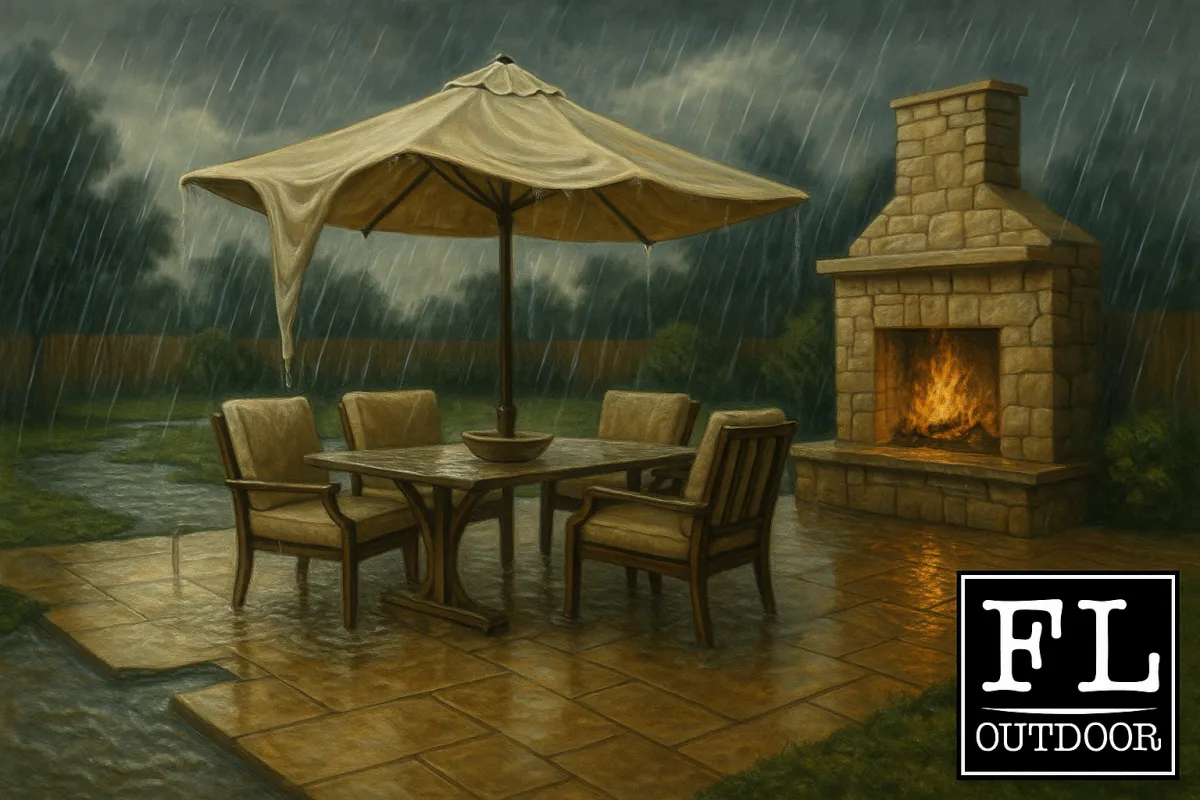
The Modern Patio Revolution, Part Two: The Patio Lies That Cost You
The Lie of the Perfect Patio
The contractor leaves.
The cushions are crisp.
The grill is gleaming.
And for a moment, you believe the lie: This patio will change everything.
Until the rain falls.
Until the sun climbs.
Until the mosquitoes arrive.
That’s when you learn the brutal truth. A patio built for a photo isn’t built for life.
The magazines never show the first puddle creeping toward your foundation. The showroom doesn’t mention that limestone turns slick as ice. And no one talks about how privacy fences that look charming in renderings won’t stop your neighbor’s gaze—or his lawnmower.
The Water Trickster
It starts innocent: a puddle in the corner. Then a rivulet across the pavers. Then, slowly, a war with your foundation.
One inch of rain on a 290-square-foot patio equals 180 gallons of water (usgs.gov). That’s a bathtub dumped onto your investment every storm.
With no drainage plan, water makes its own. Through soil. Through siding. Into basements. Into bank accounts.
Foundation repair? $10,000–$30,000. Landscaping? Another few thousand. Mold? Don’t ask.
All because no one bothered to ask the question: Where will the rain go?
The Material Mirage
That imported stone looked like luxury under showroom lights. Six months later, it’s a lawsuit waiting for rain.
The statistics aren’t flattering: darker materials push surfaces past 140°F under summer sun (energy.gov), radiating heat into homes. Tropical hardwoods demand $500–$1,000 in annual upkeep, or they decay into expensive firewood.
No wonder patios now outpace decks in new construction (nahb.org): builders learned that durability beats drama. Homeowners? Too many are still buying with their eyes, not their climate.
The Privacy Illusion
Design boards love to show pergolas. Ivy climbing. A bistro table tucked underneath.
Reality? Your patio is a stage. Your neighbors, the audience. Every meal becomes dinner theater. Every Zoom call comes with a lawnmower soundtrack.
And fixing privacy later is a triple tax: mature trees at $1,000 a piece, retrofitted motorized screens that require special posts, fences that look tacked on instead of planned.
Privacy isn’t décor. It’s dignity. Without it, your patio becomes stress, not sanctuary.
The Sunburnt Dream
At noon, the patio glows like an oven tray.
By 2 PM, the concrete scorches.
By 3 PM, you’ve retreated indoors.
Direct sunlight delivers 1,000 watts per square meter (climate.nasa.gov). On a patio, that’s like lining twenty-seven space heaters across your surface. Concrete hits 145°F. Cushions smolder. Metal chairs brand your thighs.
44% of design experts now call covered patios “essential” (icfanet.org). Umbrellas and sails? Stage props. Real shade is structural: louvers that move, awnings that think, screens that adapt.
The Bug Racket
Citronella. Zappers. Sprays. All theater.
The numbers tell the story: 195 million Americans used insect repellent in 2020—two out of three adults (cdc.gov). And yet patios remain mosquito motels, wasp colonies, ant buffets.
Professional pest control runs $400–$800 per season. Every season. Forever.
Or you build a barrier once and be done with it.
The Entertainment Lie
You built it to host. The kitchen, the firepit, the sound system.
Opening night: perfect for ninety minutes. Then guests squint in the dark. The smoke follows everyone. The chill drives people inside. By 9 PM, your patio is empty again.
37% of homeowners renovate to entertain outdoors (nar.realtor). Too many discover they built stages, not spaces.
The Storm Tax
Weather doesn’t care about your investment. Covers become sails. Pergolas catch debris. Cushions scatter like confetti.
One Florida homeowner calculated 18 hours a year spent just prepping and recovering from storms. Over 20 years? Nine work weeks gone.
Insurance often shrugs: unprotected patios equal “failure to maintain.” Translation: the bill is yours.
The Real Cost Of A Backyard Patio
That $15,000 patio? By the time you add upkeep, pest control, storm prep, furniture replacement, and inefficiency, it’s a $35,000 mistake over ten years.
And the cruelest cost isn’t financial. It’s emotional. It’s looking out at a beautiful space you almost never use.
The Protection Mandate
Every failed patio points to the same conclusion: protection is the difference between living outdoors and retreating indoors.
Drainage that tames water. Shade that beats the sun. Screens that silence the bugs. Privacy that makes a sanctuary.
Patios don’t fail because of poor taste. They fail because of poor planning.
The Path Forward
You can keep playing defense—hauling cushions, lighting citronella, watching storms undo your weekends.
Or you can join the homeowners who build smarter: who protect first, design second.
Because every unprotected patio is already counting down to its first failure.
The smartest patios of 2025 aren’t louder. They’re stronger. And they last.
Coming Next: Part Three
The Swiss Army knife of patio protection: motorized screens. From hurricane-force winds to year-round comfort, discover why this one upgrade is rewriting the future of outdoor living.
